GSDE-新凯恩斯模型-ch3
- 格式:pdf
- 大小:262.63 KB
- 文档页数:32
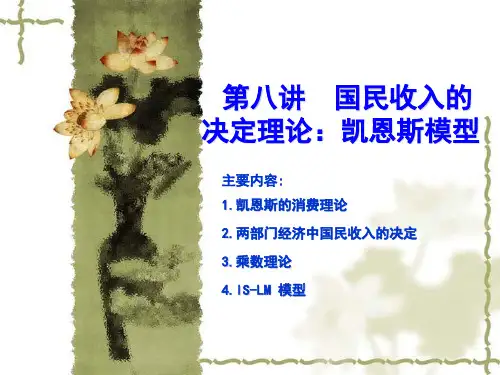
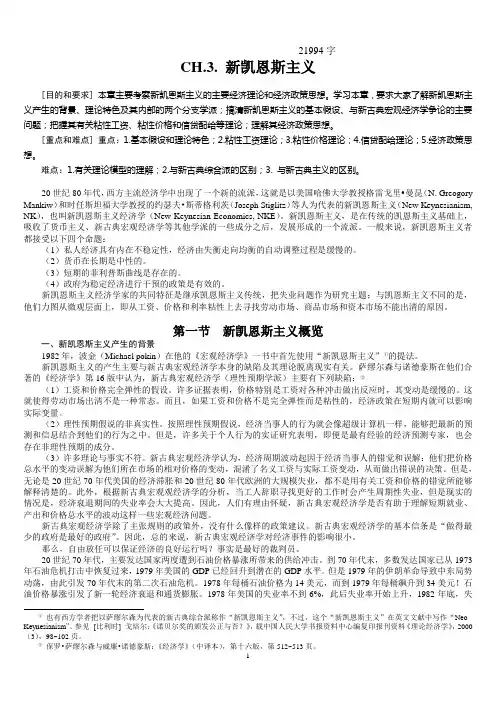
21994字CH.3. 新凯恩斯主义[目的和要求]本章主要考察新凯恩斯主义的主要经济理论和经济政策思想。
学习本章,要求大家了解新凯恩斯主义产生的背景、理论特色及其内部的两个分支学派;搞清新凯恩斯主义的基本假设、与新古典宏观经济学争论的主要问题;把握其有关粘性工资、粘性价格和信贷配给等理论;理解其经济政策思想。
[重点和难点] 重点:1.基本假设和理论特色;2.粘性工资理论;3.粘性价格理论;4.信贷配给理论;5.经济政策思想。
难点:1.有关理论模型的理解;2.与新古典综合派的区别;3. 与新古典主义的区别。
20世纪80年代,西方主流经济学中出现了一个新的流派,这就是以美国哈佛大学教授格雷戈里••曼昆(N. Greogory Mankiw)和时任斯坦福大学教授的约瑟夫•斯蒂格利茨(Joseph Stiglitz)等人为代表的新凯恩斯主义(New Keynesianism, NK),也叫新凯恩斯主义经济学(New Keynesian Economics, NKE)。
新凯恩斯主义,是在传统的凯恩斯主义基础上,吸收了货币主义、新古典宏观经济学等其他学派的一些成分之后,发展形成的一个流派。
一般来说,新凯恩斯主义者都接受以下四个命题:(1)私人经济具有内在不稳定性,经济由失衡走向均衡的自动调整过程是缓慢的。
(2)货币在长期是中性的。
(3)短期的菲利普斯曲线是存在的。
(4)政府为稳定经济进行干预的政策是有效的。
新凯恩斯主义经济学家的共同特征是继承凯恩斯主义传统,把失业问题作为研究主题;与凯恩斯主义不同的是,他们力图从微观层面上,即从工资、价格和利率粘性上去寻找劳动市场、商品市场和资本市场不能出清的原因。
第一节新凯恩斯主义概览一、新凯恩斯主义产生的背景1982年,波金(Michael pokin)在他的《宏观经济学》一书中首先使用“新凯恩斯主义”①的提法。
新凯恩斯主义的产生主要与新古典宏观经济学本身的缺陷及其理论脱离现实有关。

[经济学模型] DSGE模型讨论之八——新凯恩斯DSGE的推导,模拟,频谱分析和参数估计(初级难度)这个帖子难度为初级。
此处下载note附件:BNK_corrected1.pdf (383.44 KB)这个新凯恩斯DSGE模型是根据Jordi Gali教材的第三章修改而来的。
包括了3个核心方程,如下图第一个是:Euler equation第二个是:New Keynesian Phillips Curve第三个是:Taylor Rule其中新凯恩斯菲利普斯曲线的推导最为复杂,最简化的版本都有至少40个步骤以上的推导。
Optimisation的方法我全部用的Lagrangian,没有用任何动态规划的内容。
推导模型和建立模型一样重要。
当你自己要做研究的时候,你往往要修改别人的模型,加入和减去一些成分,所以一般自己都要重新推导整个模型,如果你对benchmark(标尺)模型非常熟练,你才会知道什么地方可以添加新东西,什么地方添加新东西也没有意义(因为推导过程中那个部分会被消掉)。
在能够独立做研究之前,都是要熟悉推导很多个(如果你非要我给数字,我会说至少100个)标尺模型及变种版本,才会有能力建立和推导自己的模型.同时我做了最大似然估计和贝叶斯估计,用的数据是Euro area的GDP per capita, CPI 和 3 month interest rate。
这些数据都要经过处理才能喂给DSGE模型。
人均GDP要用先log difference,用AR(4)预测延长4期,回到未差分数据,然后HP滤波,剔掉trend。
然后三个时间序列都要demean,意思就是全部观测值减去均值。
这个根据是来自"Frisch-Waugh-Lovell theorm"。
然后做Spectral analysis(物理学上叫光谱分析)。
我是用IRIS工具箱做得,这个Matlab 工具箱是新西兰中央银行的一个项目,专门用来模拟和估计DSGE模型,学习门槛比Dynare 高很多,需要有一定的编程基础才能看懂代码。
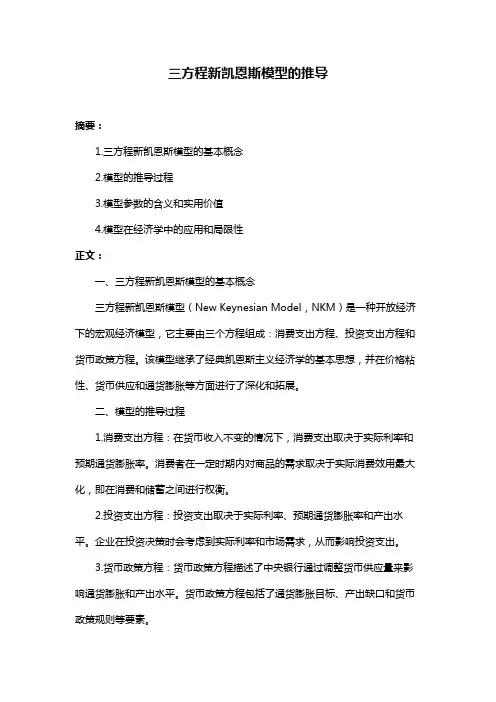
三方程新凯恩斯模型的推导摘要:1.三方程新凯恩斯模型的基本概念2.模型的推导过程3.模型参数的含义和实用价值4.模型在经济学中的应用和局限性正文:一、三方程新凯恩斯模型的基本概念三方程新凯恩斯模型(New Keynesian Model,NKM)是一种开放经济下的宏观经济模型,它主要由三个方程组成:消费支出方程、投资支出方程和货币政策方程。
该模型继承了经典凯恩斯主义经济学的基本思想,并在价格粘性、货币供应和通货膨胀等方面进行了深化和拓展。
二、模型的推导过程1.消费支出方程:在货币收入不变的情况下,消费支出取决于实际利率和预期通货膨胀率。
消费者在一定时期内对商品的需求取决于实际消费效用最大化,即在消费和储蓄之间进行权衡。
2.投资支出方程:投资支出取决于实际利率、预期通货膨胀率和产出水平。
企业在投资决策时会考虑到实际利率和市场需求,从而影响投资支出。
3.货币政策方程:货币政策方程描述了中央银行通过调整货币供应量来影响通货膨胀和产出水平。
货币政策方程包括了通货膨胀目标、产出缺口和货币政策规则等要素。
三、模型参数的含义和实用价值1.价格粘性:价格粘性是指价格在面临供需变动时调整的幅度和速度。
价格粘性假设使得模型在一定程度上解释了现实世界中物价水平变动的缓慢性。
2.预期通货膨胀:预期通货膨胀反映了市场对未来物价水平的预期。
预期通货膨胀对消费和投资决策具有重要影响,因为消费者和企业在决策时会考虑到未来的物价变动。
3.产出缺口:产出缺口是指实际产出与潜在产出之间的差距。
产出缺口反映了经济体的生产能力利用程度,对货币政策制定具有指导意义。
四、模型在经济学中的应用和局限性1.应用:三方程新凯恩斯模型在经济学中的应用主要包括货币政策分析、宏观经济稳定性和经济增长等方面。
通过模型分析,研究者可以探讨货币政策如何影响通货膨胀、产出和就业等宏观经济变量。
2.局限性:尽管三方程新凯恩斯模型在一定程度上解释了现实世界中的宏观经济现象,但模型仍存在局限性。
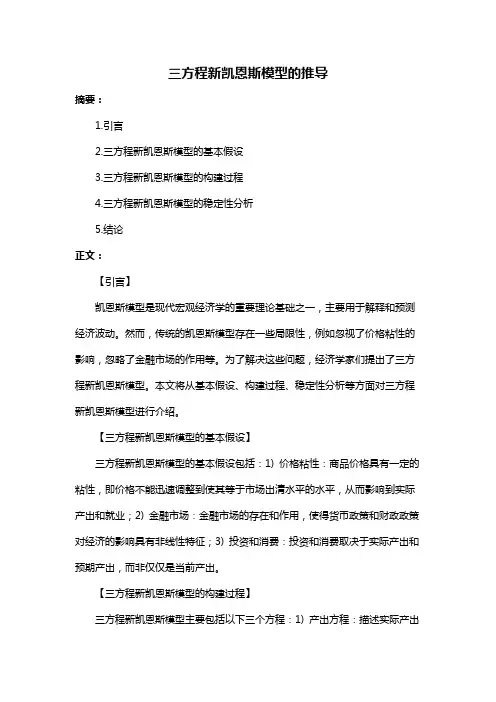
三方程新凯恩斯模型的推导摘要:1.引言2.三方程新凯恩斯模型的基本假设3.三方程新凯恩斯模型的构建过程4.三方程新凯恩斯模型的稳定性分析5.结论正文:【引言】凯恩斯模型是现代宏观经济学的重要理论基础之一,主要用于解释和预测经济波动。
然而,传统的凯恩斯模型存在一些局限性,例如忽视了价格粘性的影响,忽略了金融市场的作用等。
为了解决这些问题,经济学家们提出了三方程新凯恩斯模型。
本文将从基本假设、构建过程、稳定性分析等方面对三方程新凯恩斯模型进行介绍。
【三方程新凯恩斯模型的基本假设】三方程新凯恩斯模型的基本假设包括:1) 价格粘性:商品价格具有一定的粘性,即价格不能迅速调整到使其等于市场出清水平的水平,从而影响到实际产出和就业;2) 金融市场:金融市场的存在和作用,使得货币政策和财政政策对经济的影响具有非线性特征;3) 投资和消费:投资和消费取决于实际产出和预期产出,而非仅仅是当前产出。
【三方程新凯恩斯模型的构建过程】三方程新凯恩斯模型主要包括以下三个方程:1) 产出方程:描述实际产出与资本存量、劳动力、生产率等因素之间的关系;2) 价格方程:描述价格水平与产出、货币供应、进口价格等因素之间的关系;3) 货币方程:描述货币供应与利率、预期产出、投资等因素之间的关系。
这三个方程同时考虑了实际经济变量和金融市场变量,从而更全面地描述了经济运行的规律。
【三方程新凯恩斯模型的稳定性分析】通过对三方程新凯恩斯模型进行稳定性分析,可以得出以下结论:1) 当经济受到冲击时,如产出下降或货币供应增加,实际产出和就业会受到一定程度的影响;2) 在金融市场存在和价格粘性的背景下,货币政策和财政政策的效果可能受到削弱;3) 投资和消费对实际产出和预期产出的反应有助于解释经济波动的持续性和波动幅度。
【结论】总之,三方程新凯恩斯模型在传统凯恩斯模型的基础上,考虑了价格粘性、金融市场等因素,使得其对经济现象的解释和预测能力得到提高。
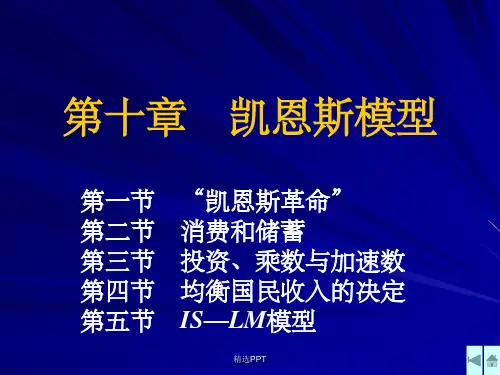
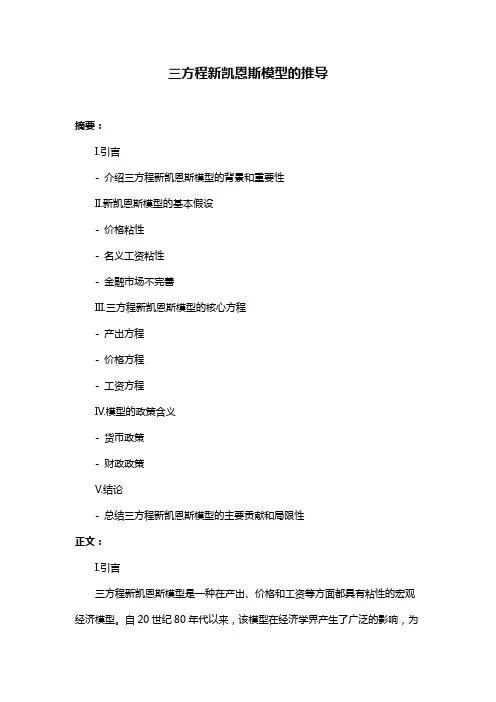
三方程新凯恩斯模型的推导摘要:I.引言- 介绍三方程新凯恩斯模型的背景和重要性II.新凯恩斯模型的基本假设- 价格粘性- 名义工资粘性- 金融市场不完善III.三方程新凯恩斯模型的核心方程- 产出方程- 价格方程- 工资方程IV.模型的政策含义- 货币政策- 财政政策V.结论- 总结三方程新凯恩斯模型的主要贡献和局限性正文:I.引言三方程新凯恩斯模型是一种在产出、价格和工资等方面都具有粘性的宏观经济模型。
自20世纪80年代以来,该模型在经济学界产生了广泛的影响,为我们理解现实世界中的宏观经济现象提供了有力的理论工具。
本文将详细阐述三方程新凯恩斯模型的推导过程,并分析其政策含义。
II.新凯恩斯模型的基本假设为了更好地描述现实世界中的经济现象,新凯恩斯模型在以下三个方面对传统的凯恩斯模型进行了拓展:1.价格粘性:新凯恩斯模型假设价格具有粘性,即价格调整存在一定的时间滞后。
这意味着在短期内,企业无法立即调整所有价格,而需要花费一定的时间来完成价格调整。
2.名义工资粘性:新凯恩斯模型假设名义工资也具有粘性。
在现实中,由于劳动合同、劳动力市场信息不对称等因素,企业无法立即调整所有员工的工资。
因此,名义工资的调整也存在一定的时间滞后。
3.金融市场不完善:新凯恩斯模型认为金融市场并不完善,存在所谓的“金融摩擦”。
这使得在面临冲击时,企业和家庭可能无法立即调整其支出和投资行为,从而对实际经济产生影响。
III.三方程新凯恩斯模型的核心方程在三方程新凯恩斯模型中,产出、价格和工资分别由以下三个方程来描述:1.产出方程:Y = AKαY-MUY其中,Y表示产出,A表示生产率,K表示资本存量,α表示资本产出弹性,M表示货币供应,U表示失业率,MUY表示货币需求对产出和利率的函数。
2.价格方程:π = π^e + θ(Y - Y*)其中,π表示价格水平,π^e表示预期价格水平,θ表示价格粘性参数,Y表示产出水平,Y*表示潜在产出水平。

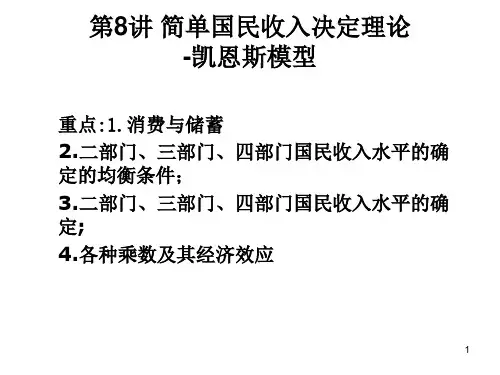

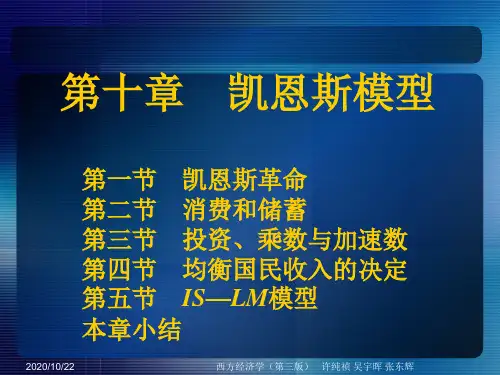
Lectures on Monetary Policy,In‡ation and the Business CycleThe Basic New Keynesian ModelbyJordi GalíFebruary2007Motivation and OutlineEvidence on Money,Output,and Prices:The Long RunShort Run E¤ects of Monetary Policy Shocks(i)persistent e¤ects on real variables(ii)slow adjustment of aggregate price level(iii)liquidity e¤ectMicro Evidence on Price-setting Behavior:signi…cant price and wage rigiditiesFailure of Classical Monetary ModelsA Baseline Model with Nominal Rigiditiesmonopolistic competitionsticky prices(staggered price setting)competitive labor markets,closed economy,no capital accumulationHouseholdsRepresentative household solves1X t=0 t U(C t;N t)max E0whereC t Z10C t(i)1 1 di 1 subject to Z10P t(i)C t(i)di+Q t B t B t 1+W t N t T tfor t=0;1;2;:::plus solvency constraint.Optimality conditions1.Optimal allocation of expendituresC t(i)= P t(i)P t C t implying Z10P t(i)C t(i)di=P t C t whereP t Z10P t(i)1 di 11 2.Other optimality conditionsU n;t Uc;t =W tP tQ t= E t U c;t+1U c;t P t P t+1Speci…cation of utility:U(C t;N t)=C1t1N1+'t1+'implied log-linear optimality conditions(aggregate variables)w t p t= c t+'n tc t=E t f c t+1g 1 (i t E t f t+1g )where i t log Q t is the nominal interest rate and log is the discount rate.Ad-hoc money demandm t p t=y t i tFirmsContinuum of…rms,indexed by i2[0;1]Each…rm produces a di¤erentiated goodIdentical technologyY t(i)=A t N t(i)1Probability of being able to reset price in any given period:1 , independent across…rms(Calvo(1983)).2[0;1]:index of price stickinessImplied average price duration11Aggregate Price DynamicsP t= (P t 1)1 +(1 )(P t)1 11Dividing by P t 1:= +(1 ) P t P t 1 11tLog-linearization around zero in‡ation steady statet=(1 )(p t p t 1)(1) or,equivalentlyp t= p t 1+(1 )p tOptimal Price Setting1X k=0 k E t Q t;t+k P t Y t+k j t t+k(Y t+k j t) maxP tsubject toY t+k j t=(P t=P t+k) C t+kfor k=0;1;2;:::whereQ t;t+k k C t+k C t P t P t+kOptimality condition:1X k=0 k E t Q t;t+k Y t+k j t P t M t+k j t =0 where t+k j t 0t+k(Y t+k j t)and M 1Equivalently,1X k=0 k E t Q t;t+k Y t+k j t P t P t 1 M MC t+k j t t 1;t+k =0 where MC t+k j t t+k j t=P t+k and t 1;t+k P t+k=P t 1Perfect Foresight,Zero In‡ation Steady State:P t P t 1=1; t 1;t+k=1;Y t+k j t=Y;Q t;t+k= k;MC=1MLog-linearization around zero in‡ation steady state:1X k=0( )k E t f c mc t+k j t+p t+k p t 1g p t p t 1=(1 )Equivalently,1X k=0( )k E t f mc t+k+p t+k gp t= +(1 )Flexible prices( =0):p t= +mc t+p t=)mc t= (symmetric equilibrium)Particular Case: =0(constant returns)=)MC t+k j t=MC t+kLog-linearization of optimality condition around zero in‡ation steady state: p t p t 1=1X k=0( )k E t f(1 )c mc t+k+ t+k g(2)= E t f p t+1 p t g+(1 )c mc t+ t(3) where cmc t mc t mc=mc t+ ,and log 1.Combining(1)and(3):t= E t f t+1g+ c mc twhere(1 )(1 )Generalization to 2(0;1)(decreasing returns)De…nemc t (w t p t ) mpn t(w t p t ) 11(a t y t ) log(1 )Using mc t +k j t =(w t +k p t +k ) 11 (a t +k y t +k j t ) log(1 ),mc t +k j t=mc t +k +1 (y t +k j t y t +k )=mc t +k1(p t p t +k )(4)Implied in‡ation dynamicst = E t f t +1g + c mc t(5)where(1 )(1 )1 1 +EquilibriumGoods markets clearingY t(i)=C t(i)for all i2[0;1]and all t.Letting Y t R10Y t(i)1 1 di 1,Y t=C tfor all bined with the consumer’s Euler equation:y t=E t f y t+1g 1 (i t E t f t+1g )(6)Labor market clearingN t=Z10N t(i)di=Z10 Y t(i)A t 11 di= Y t A t 11 Z10 P t(i)P t 1 di T aking logs,(1 )n t=y t a t+d t where d t (1 )log R10(P t(i)=P t) 1 di(second order). Up to a…rst order approximation:y t=a t+(1 )n tMarginal Cost and Outputmc t=(w t p t) mpn t=( y t+'n t) (y t n t) log(1 )= +'+ 1 y t 1+'1 a t log(1 )(7) Under‡exible pricesmc= +'+ 1 y n t 1+'1 a t log(1 )(8)=)y n t= y+ya a twhere y ( log(1 ))(1 )+'+ (1 )>0and ya 1+'+'+ (1 ).=)cmc t= +'+ 1 (y t y n t)(9) where y t y n t e y t is the output gapNew Keynesian Phillips Curvet= E t f t+1g+ e y t(10) where +'+ 1 .Dynamic IS equatione y t=E tf e y t+1g 1 (i t E t f t+1g r n t)(11) where r n t is the natural rate of interest,given byr n t + E t f y n t+1g= + ya E t f a t+1gMissing block:description of monetary policy(determination of i t).Equilibrium under a Simple Interest Rate Rulei t= + t+ y e y t+v t(12) where v t is exogenous(possibly stochastic)with zero mean. Equilibrium Dynamics:combining(10),(11),and(12)e y t t =A T E tf e y t+1g E t f t+1g +B T(b r n t v t)(13) whereA T 1+ ( + y) ;B T 1and 1+ y+Uniqueness()A T has both eigenvalues within the unit circle Given 0and y 0,(Bullard and Mitra(2002)):( 1)+(1 ) y>0is necessary and su¢cient.E¤ects of a Monetary Policy ShockSet b r n t=0(no real shocks).Let v t follow an AR(1)processv t= v v t 1+"v tCalibration:v=0:5, =1:5, y=0:5=4, =0:99, ='=1, =2=3, =4. Dynamic e¤ects of an exogenous increase in the nominal rate(Figure1): Exercise:analytical solutionE¤ects of a Technology ShockSet v t=0(no monetary shocks).T echnology process:a t= a a t 1+"a t:Implied natural rate:b r n t= ya(1 a)a t Dynamic e¤ects of a technology shock( a=0:9)(Figure2) Exercise:AR(1)process for a tEquilibrium under an Exogenous Money Growth Processm t= m m t 1+"m t(14) Money market clearingb l t=b y t b i t(15)=e y t+b y n t b i t(16) where l t m t p t denotes(log)real money balances.Substituting(15)into(11):(1+ )e y t= E t f e y t+1g+b l t+ E t f t+1g+ b r n t b y n t(17) Furthermore,we haveb l t 1=b l t+ t m t(18)Equilibrium dynamicsA M;024e y t t b l t 135=A M;124E t f e y t+1g E t f t+1gb l t 135+B M24b r n tb y n t m t35(19)whereA M;0 241+ 00100 1135;A M;124 10 000135;B M24 1000000 135Uniqueness()A M A 1M;0A M;1has two eigenvalues inside and one outside the unit circle.E¤ects of a Monetary Policy ShockSet b r n t=y n t=0(no real shocks).Money growth processm t= m m t 1+"m t(20) where m2[0;1)Figure3(based on m=0:5)E¤ects of a Technology ShockSet m t=0(no monetary shocks).T echnology process:a t= a a t 1+"a t:Figure4(based on a=0:9).Empirical EvidenceTechnical AppendixOptimal Allocation of Consumption ExpendituresMaximization of C t for any given expenditure level R10P t(i)C t(i)di Z t can be formalized by means of the LagrangeanL= Z10C t(i)1 1 di 1 Z10P t(i)C t(i)di Z tThe associated…rst order conditions are:C t(i) 1 C t1 = P t(i)for all i2[0;1].Thus,for any two goods(i;j)we have:C t(i)=C t(j) P t(i)P t(j)which can be plugged into the expression for consumption expenditures to yieldC t(i)= P t(i)P t Z t P tfor all i2[0;1].The latter condition can then be substituted into the de…nition of C t,yieldingZ10P t(i)C t(i)di=P t C tCombining the two previous equations we obtain the demand schedule:C t(i)= P t(i)P t C tLog-Linearized Euler EquationWe can rewrite the Euler equation as1=E t f exp(i t c t+1 t+1 )g(21) In a perfect foresight steady state with constant in‡ation and constant growth we must have:i= + +with the steady state real rate being given byr i= +A…rst order Taylor expansion of exp(i t c t+1 t+1 )around that steady state yields:exp(i t c t+1 t+1 )'1+(i t i) ( c t+1 ) ( t+1 )=1+i t c t+1 t+1which can be used in(21)to obtain,after some rearrangement of terms,the log-linearized Euler equationc t=E t f c t+1g 1 (i t E t f t+1g )Aggregate Price Level DynamicsLet S(t) [0;1]denote the set of…rms which do not re-optimize their posted price in period t.The aggregate price level evolves according toP t= Z S(t)P t 1(i)1 di+(1 )(P t)1 11= (P t 1)1 +(1 )(P t)1 11where the second equality follows from the fact that the distribution of prices among…rms not adjusting in period t corresponds to the distribution of e¤ective prices in period t 1,with total mass reduced to .Equivalently,dividing both sides by P t 1:= +(1 ) P t P t 1 1 (22)1twhere t P t P t 1.Notice that in a steady state with zero in‡ation P t=P t 1:Log-linearization around a zero in‡ation( =1)steady state implies:t=(1 )(p t p t 1)(23)Price DispersionFrom the de…nition of the price index:1=Z10 P t(i)P t 1 "di=Z10exp f(1 )(p t(i) p t)g di'1+(1 )Z10(p t(i) p t)di+(1 )22Z10(p t(i) p t)2dithus implying the second order approximationp t'E i f p t(i)g+(1 )2Z10(p t(i) p t)2diwhere E i f p t (i )gR 10p t (i )di is the cross-sectional mean of (log)prices.In addition,Z 10 P t (i )P t 1 di =Z 10exp1 (p t (i ) p t ) di '1 1 Z 10(p t (i ) p t )di +12 1 2Z 10(p t (i ) p t )2di '1+12 (1 )1 Z 10(p t (i ) p t )2di +12 1 2Z 10(p t (i ) p t )2di =1+12 1 1 Z 10(p t (i ) p t )2di '1+12 1 1 var i f p t (i )g >1where 1 1 + ,and where the last equality follows from the observation that,up to second order,Z 10(p t (i ) p t )2di 'Z 10(p t (i ) E i f p t (i )g )2di var i f p t (i )gFinally,using the de…nition of d t we obtain d t (1 )log Z 10 P t (i )P t 1 di '12 var i f p t (i )g。